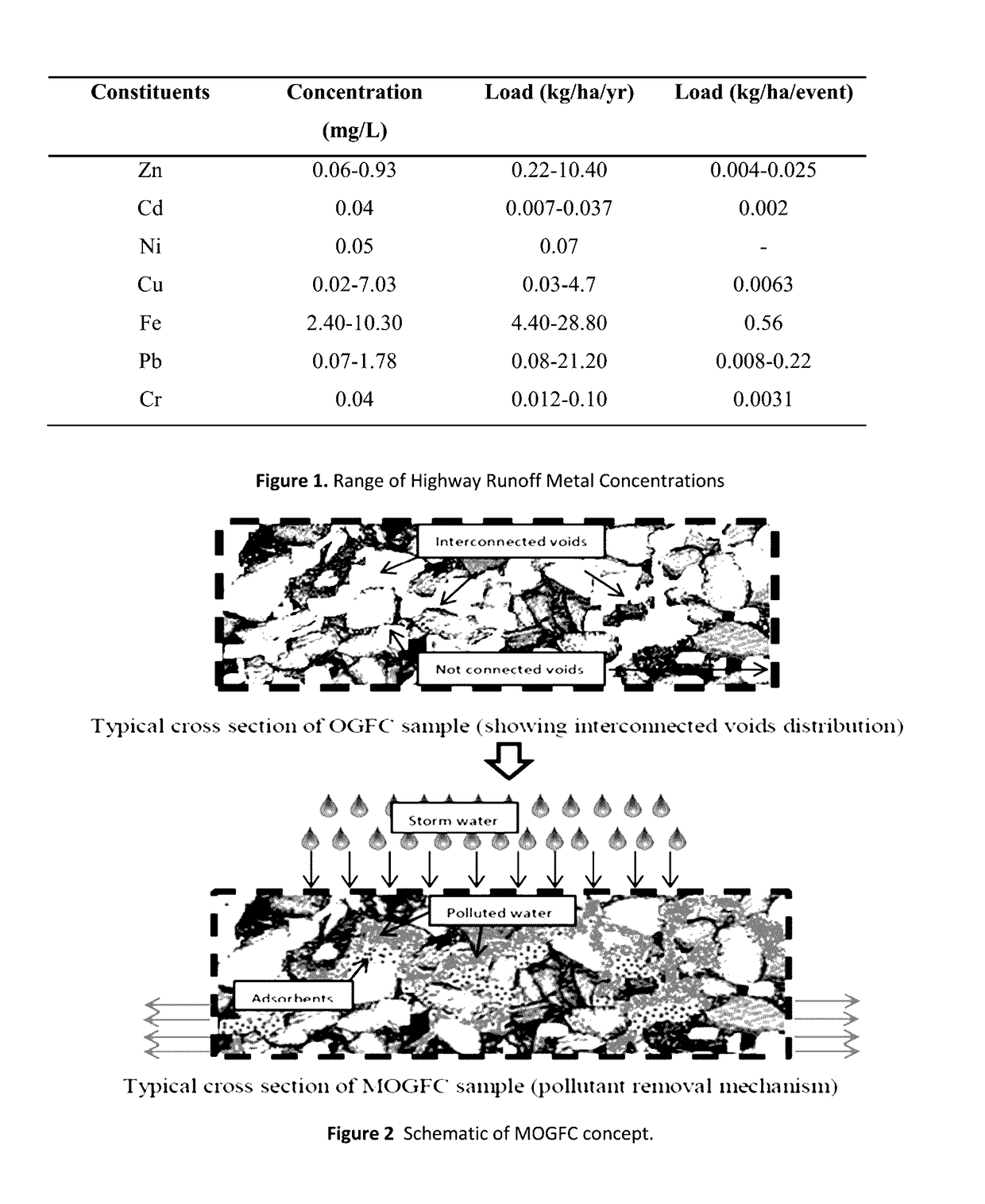Multi-functional open graded friction course for in situ treatment of highway or roadway runoff
a technology of in situ treatment and highway runoff, applied in the field of multi-functional open graded friction course, can solve the problems of water quality degradation, highway runoff can have chronic toxicity, accumulation of pollutants,
- Summary
- Abstract
- Description
- Claims
- Application Information
AI Technical Summary
Benefits of technology
Problems solved by technology
Method used
Image
Examples
example 1
[0047]Various embodiments of OGFC were prepared with different air voids with the same aggregate composition, as shown in FIG. 3. The air voids were varied by keeping the sample thickness constant and changing the mass and compaction level (the number of gyrations) using a Superpave Gyratory Compactor. Limestone aggregates and viscosity graded polymer modified asphalt binder (PAC-40) were used to construct OGFC samples. Both materials were obtained from local contractors. The mix design yielded 5.5% asphalt content and 22% total air voids in the mixture at 50 gyrations. All samples used in the example were approximately 150 mm (approximately 5.9 inches) in diameter and approximately 76 mm (approximately 3 inches) thick. The aggregate gradation used in this example is shown in the table in FIG. 4.
[0048]Adsorbent dosage, as a percentage by mass of the OGFC sample, was determined. Then a portion of the total amount of adsorbent was evenly distributed on the surface of the sample. The O...
example 2
[0058]The adsorption of Cu and Zn on different adsorbents was carried out using the batch method explained in Example 1 at approximately room temperature (approximately 25° C.). A desired amount of adsorbent was placed in several 250 ml conical flasks. Approximately 100 ml of approximately 5 mg / L concentration Cu solution was prepared and mixed with the adsorbent to test the adsorption capacities. Similarly, a Zn solution of approximately 5 mg / L concentration was prepared and mixed with the adsorbent to test the adsorption capacities. One sample of the same concentration without adsorbent (blank) was also prepared and treated under the same condition. The solution without adsorbent was used as a reference to establish the initial concentration for the flasks containing adsorbent. All conical flasks were capped and placed on an Excella incubator shaker (Model E24, New Brunswick Scientific Co.) for approximately 24 hours. The flasks were then removed and solutions were filtered using ...
example 3
[0071]A metal removal test was conducted using the Florida Department of Transportation's Falling Head Laboratory Permeability Test equipment, as shown in FIG. 5. Each MOGFC embodiment was placed inside the metal cylinder following the same procedures described in Example 1. The permeameter valve was adjusted to allow approximately 1000-mL of metal solution to pass through the MOGFC sample at a relatively constant rate while being timed. The whole filtration took approximately 1.5 hours. The metal concentration of the filtrate was analyzed by the AAS. Finally, the percentage of metal removal was calculated by subtracting the final concentration from the initial concentration using Eq. 5.
%MetalRemovalEfficiency=(C∘-Cf)C∘×100(5)
[0072]The Cu and Zn removal efficiencies of MOGFC with different bentonite dosages is plotted in FIGS. 18 and 19, respectively. The maximum amount of bentonite included in a MOGFC sample was approximately 0.70% of the total mass. Conventional OGFC, without any ...
PUM
| Property | Measurement | Unit |
|---|---|---|
| thick | aaaaa | aaaaa |
| thick | aaaaa | aaaaa |
| diameter | aaaaa | aaaaa |
Abstract
Description
Claims
Application Information
 Login to View More
Login to View More - R&D
- Intellectual Property
- Life Sciences
- Materials
- Tech Scout
- Unparalleled Data Quality
- Higher Quality Content
- 60% Fewer Hallucinations
Browse by: Latest US Patents, China's latest patents, Technical Efficacy Thesaurus, Application Domain, Technology Topic, Popular Technical Reports.
© 2025 PatSnap. All rights reserved.Legal|Privacy policy|Modern Slavery Act Transparency Statement|Sitemap|About US| Contact US: help@patsnap.com



